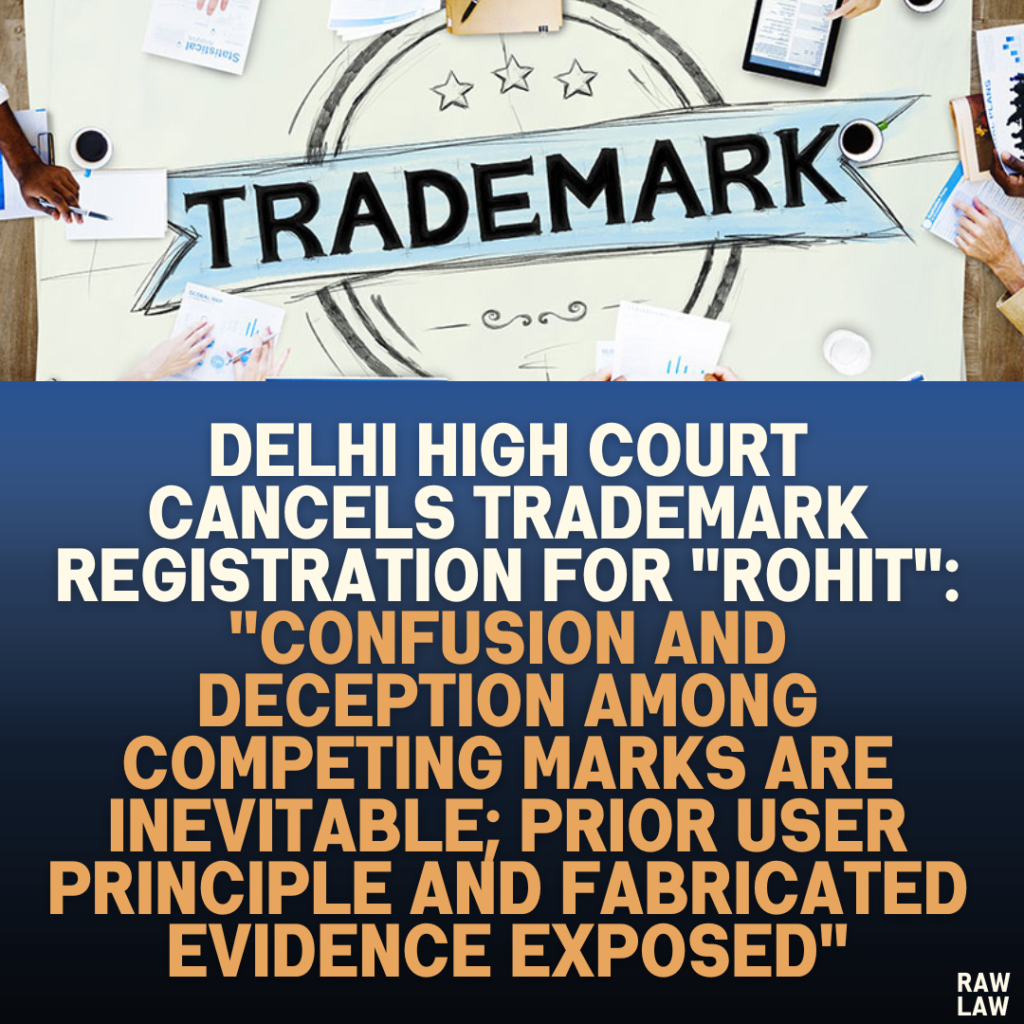Court’s Decision
The Delhi High Court allowed the rectification petition filed by the petitioner and directed the cancellation of the respondent’s trademark registration for the mark “ROHIT” under Class 17. The Court concluded that:
- The respondent’s trademark was deceptively similar to the petitioner’s trademark.
- The respondent’s claim of prior usage (since 2005) was based on fabricated and unsubstantiated evidence.
- The use of a similar mark by the respondent caused confusion and deception among consumers.
The Court ordered the Trade Marks Registry to rectify its register and issue a public notification about the cancellation of the respondent’s trademark.
Facts of the Case
- Petitioner’s Background:
- The petitioner is a partnership firm incorporated in 2000 and engaged in manufacturing and trading PVC pipes.
- It adopted the trademark “ROHIT Wrapers” and its variants, including “Rohit Tubes” and “Rohit Durable,” as early as 2000.
- The petitioner provided substantial documentation to establish its continuous use of the trademark, including:
- Invoices from 2004 to 2016.
- A TIN Registration from 2000.
- Central Excise Registration from 2002.
- BIS certification for PVC pipes from 2003.
- Respondent’s Claim:
- The respondent registered the trademark “ROHIT” in 2012 under Class 17 for PVC pipes and fittings, claiming usage since 2005.
- The respondent’s partnership, operating under the name “Hariom and Company,” had no inherent connection to the word “ROHIT.”
- Petitioner’s Allegations:
- The petitioner alleged that the respondent’s trademark was deceptively similar to its own, creating confusion among consumers.
- The petitioner also alleged that the respondent fabricated documents to falsely claim prior usage since 2005.
- Fabrication of Evidence:
- The petitioner highlighted discrepancies in the respondent’s documents, such as invoices from 2005-2006 showing a TIN number that was issued only in 2007.
Issues
- Was the respondent’s trademark deceptively similar to the petitioner’s trademark, thereby causing confusion among consumers?
- Did the respondent provide credible evidence to substantiate its claim of prior usage since 2005?
Petitioner’s Arguments
- Prior Adoption and Use:
- The petitioner had been using the trademark “ROHIT” since 2000, long before the respondent’s claimed usage in 2005.
- The trademark had gained significant goodwill and recognition in the market over two decades.
- Deceptive Similarity:
- The respondent’s mark was phonetically, visually, and structurally similar to the petitioner’s mark.
- This similarity caused confusion among consumers, especially since both parties operated in the same industry.
- Fabricated Evidence:
- The respondent’s documents claiming usage since 2005 were falsified, as evidenced by the inclusion of a TIN number that was issued only in 2007.
- Bad Faith Adoption:
- The respondent adopted the mark “ROHIT” dishonestly to capitalize on the petitioner’s established reputation.
Respondent’s Arguments
- Prior Usage:
- The respondent claimed to have been using the impugned mark since 2005 and provided invoices as proof.
- Validity of Registration:
- The respondent argued that its registration in 2012 was lawful, and the petitioner had not opposed it during the statutory period.
- Distinctive Ownership:
- The respondent asserted that it was the lawful owner of the trademark and had been conducting substantial business under the mark since 2005.
Analysis of the Law
- Deceptive Similarity:
- Section 11 of the Trade Marks Act, 1999: Prohibits registration of marks that are deceptively similar to earlier marks and likely to cause confusion.
- The Court found that the respondent’s mark was phonetically and visually similar to the petitioner’s mark, causing consumer confusion.
- Fabricated Evidence:
- The respondent’s invoices were found to be falsified, as they included a TIN number that was issued two years after the claimed usage began.
- Prior User Principle:
- Trademark law gives priority to the first user of a mark. The petitioner provided substantial evidence of its usage since 2000, while the respondent’s claim of usage since 2005 was unsubstantiated.
- Honest Concurrent Use:
- The respondent could not claim honest concurrent use, as its adoption of the mark was in bad faith and aimed at exploiting the petitioner’s goodwill.
- Precedents Applied:
- M/S South India Beverages v. General Mills: Highlighted the importance of the dominant feature of a trademark.
- Indian Express v. Shivhare: Held that the use of a mark in a different language script could still cause confusion.
- M/S Bhatia Plastics v. Peacock Industries: Observed that translation of trademarks into another language can lead to consumer deception.
Court’s Reasoning
- Fabrication of Documents:
- The Court identified glaring anomalies in the respondent’s invoices, which rendered its claim of usage since 2005 false.
- Dominant Feature of the Mark:
- The petitioner’s mark “ROHIT” was the dominant feature, and the respondent’s adoption of a Hindi variant did not diminish its similarity or likelihood of confusion.
- Likelihood of Confusion:
- In a multilingual society like India, consumers are likely to confuse trademarks that are similar in different scripts.
Conclusion
The Court held that:
- The petitioner was the prior user of the trademark “ROHIT” and had gained significant goodwill and reputation.
- The respondent’s adoption of a similar mark was dishonest, and its claim of prior usage was based on fabricated evidence.
- The respondent’s mark created confusion and deception among consumers, amounting to infringement.
The Court canceled the respondent’s trademark registration and directed the Trade Marks Registry to rectify its records.
Implications
- Clarity on Deceptive Similarity:
- The judgment reinforces that trademarks with deceptive similarity cannot coexist, even if they are in different languages or scripts.
- Strengthening Prior User Rights:
- The decision underscores the importance of the prior user principle in trademark law.
- Discouraging Fraudulent Practices:
- The ruling discourages bad faith adoption of trademarks and fabrication of evidence, ensuring fair competition in the marketplace.




Pingback: Supreme Court Acquits Man Convicted of Dacoity: “Prosecution Failed to Prove Guilt Beyond Reasonable Doubt”; Witness Contradictions and Lack of Forensic Evidence Fatal to Case - Raw Law